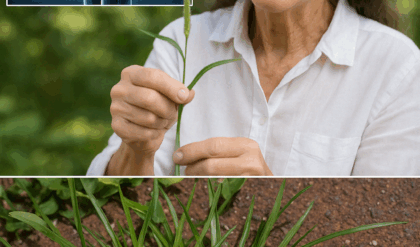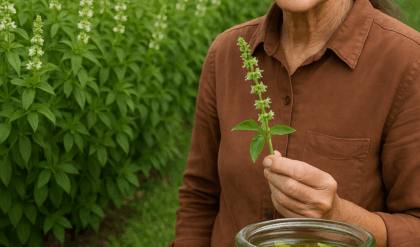What if the weed you’ve been pulling from your garden is a nutritional powerhouse waiting to transform your health? Lamb’s quarters (Chenopodium album), often called wild spinach or goosefoot, is a common plant dismissed as a nuisance but revered in traditional diets for its exceptional nutrient density. Packed with vitamins, minerals, and antioxidants, this humble green rivals spinach and kale, offering a free, sustainable way to boost immunity, support digestion, and promote vitality. In this comprehensive guide, we’ll unveil the science-backed benefits of lamb’s quarters, how to use it safely, and why it deserves a spot in your diet. Ready to rethink this backyard “weed”? Let’s dive into the surprising world of lamb’s quarters.

Why Lamb’s Quarters Is a Wellness Powerhouse 🌿
Lamb’s quarters is a nutritional gem hiding in plain sight. Its leaves and young shoots are rich in vitamins A, C, and K, plus minerals like calcium, magnesium, and iron, often surpassing cultivated greens. The plant’s protein content and antioxidants, including beta-carotene, combat inflammation and oxidative stress. Native to Europe and Asia but found worldwide, it’s a staple in traditional cuisines from India to the Americas, thriving in disturbed soils like gardens and farms. Affordable and eco-friendly, lamb’s quarters is a sustainable superfood for natural wellness.
Science-Backed Benefits of Lamb’s Quarters 🩺
Research and traditional use highlight the remarkable benefits of lamb’s quarters, making it a versatile addition to a healthy diet:
- Immune Support: A single cup provides 96% of the daily value for vitamin C and 73% for vitamin A, strengthening immunity and fighting infections.
- Bone Health: High calcium (31% DV per 100g) and vitamin K support bone density, reducing osteoporosis risk.
- Anti-Inflammatory Relief: Antioxidants like beta-carotene reduce inflammation, easing joint pain and chronic conditions.
- Digestive Wellness: Fiber promotes regular bowel movements, while its mild diuretic properties aid detoxification, as noted in herbal traditions.
- Heart Health: Magnesium and potassium help regulate blood pressure, supporting cardiovascular wellness.
- Skin and Wound Healing: When chewed into a paste, leaves soothe insect bites, minor cuts, and sunburns by reducing inflammation.
- Energy Boost: Iron and B vitamins, including riboflavin (37% DV) and B6 (21% DV), combat fatigue and support metabolism.
These benefits make lamb’s quarters a nutrient-dense ally for vibrant health.
How to Use Lamb’s Quarters Safely and Effectively 🍽️
Lamb’s quarters is edible raw or cooked, with leaves, shoots, flowers, and seeds offering culinary versatility. Here’s how to incorporate it:
- Fresh Leaves: Add young, tender leaves to salads for a spinach-like flavor with a slightly salty note from mineral-rich dust.
- Cooked Greens: Sauté, steam, or boil leaves and shoots as a side dish or mix into soups, stir-fries, or casseroles. Cooking reduces oxalic acid, which can cause throat irritation in older leaves.
- Seeds: Harvest in fall, dry, and grind into flour for bread or sprout for nutrient-packed microgreens.
- Tea: Boil leaves for 10 minutes to make a tea that supports digestion and relieves stomach aches or diarrhea.
- Poultice: Chew fresh leaves into a paste and apply to skin for bites, scrapes, or inflammation relief.
Start with small amounts to assess tolerance, as oxalic acid in mature leaves may irritate sensitive stomachs.
Culinary Uses for a Nutritious Twist 🎨
Lamb’s quarters shines in the kitchen with its creamy texture and mild, salty flavor:
- Salad Star: Mix young leaves with dandelion greens and nuts for a foraged salad.
- Smoothie Boost: Blend leaves with berries and yogurt for a vitamin-packed drink.
- Seasoning Powder: Dry leaves and grind with spices for a nutritious salt substitute.
- Soup Enhancer: Add to lentil or vegetable soups for a spinach-like richness.
These uses make lamb’s quarters a versatile, health-boosting ingredient.
Precautions for Safe Use ⚠️
While safe for most, lamb’s quarters requires mindful use:
- Moderation: High oxalic acid in older leaves may cause digestive discomfort or kidney issues if overconsumed. Cook mature leaves to reduce oxalic acid.
- Foraging: Harvest from clean, pesticide-free areas, as lamb’s quarters often grows in disturbed soils like roadsides.
- Allergies: Test a small amount if new to foraged greens, as rare reactions may occur.
- Identification: Ensure correct identification, as look-alikes like nightshades can be toxic. Look for diamond-shaped, toothed leaves with a waxy, whitish coating.
Use fresh, young plants from trusted sources for optimal safety and flavor.
Sustainable Wellness with Lamb’s Quarters 🌍
Lamb’s quarters is eco-friendly, thriving in bare soils without cultivation. Foraging or allowing it to grow in your garden supports sustainable practices. By choosing this wild superfood, you reduce food waste and reliance on store-bought greens, benefiting your health and the planet.
Tips for Making It a Habit 📅
Incorporate lamb’s quarters into your routine by foraging or cultivating a patch in your garden. Use weekly in salads, teas, or cooked dishes for consistent benefits. Pair with healthy habits like hydration or exercise for holistic wellness. Share your recipes with friends to inspire a community of foragers and health enthusiasts.
Your Path to Radiant Health
Lamb’s quarters is a superfood revelation, turning a common weed into a nutrient-packed ally for immunity, digestion, and vitality. Its science-backed benefits and culinary versatility empower you to thrive naturally. Start small, use safely, and watch your health soar. Ready to embrace this backyard treasure? Forage some lamb’s quarters today and unlock a healthier, more vibrant you.





